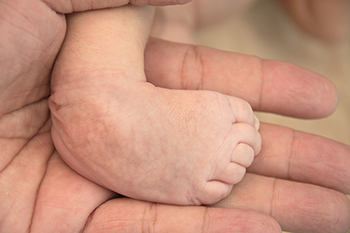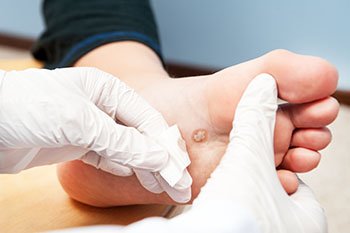Connect With Us
Blog

People who enjoy running or jogging may be concerned if a bunion develops. A bunion is a bony protrusion that forms on the side of the big toe and is uncomfortable while wearing shoes. As the bunion grows, it may alter the foot structure, and cause the other toes to shift toward each other. A bunion is considered to be a deformity and may cause pain and discomfort. Runners may have to alter their gait to accommodate the bunion, and medical attention is often sought so their running or jogging routine may resume to normal. A common cause of bunions can come from wearing shoes that do not have ample room in the toe area. High heels fit into this category, which may cause the toes to squeeze together. It may also happen from genetic reasons, which may give people fair warning to wisely choose shoes that fit correctly. Some patients have found temporary relief for mild bunions by wearing a protective covering over it. If you have developed a bunion, it is suggested that you speak with a podiatrist who can guide you toward the correct treatment methods, which may include surgery for permanent removal.
If you are suffering from bunion pain, contact Thi Pham, DPM of Foot Specialists of Tri-County. Our doctor can provide the care you need to keep you pain-free and on your feet.
What Is a Bunion?
Bunions are painful bony bumps that usually develop on the inside of the foot at the joint of the big toe. As the deformity increases over time, it may become painful to walk and wear shoes. Women are more likely to exacerbate existing bunions since they often wear tight, narrow shoes that shift their toes together. Bunion pain can be relieved by wearing wider shoes with enough room for the toes.
Causes
- Genetics – some people inherit feet that are more prone to bunion development
- Inflammatory Conditions - rheumatoid arthritis and polio may cause bunion development
Symptoms
- Redness and inflammation
- Pain and tenderness
- Callus or corns on the bump
- Restricted motion in the big toe
In order to diagnose your bunion, your podiatrist may ask about your medical history, symptoms, and general health. Your doctor might also order an x-ray to take a closer look at your feet. Nonsurgical treatment options include orthotics, padding, icing, changes in footwear, and medication. If nonsurgical treatments don’t alleviate your bunion pain, surgery may be necessary.
If you have any questions, please feel free to contact our offices located in Sulphur Springs, Winnsboro, and Pittsburg, TX . We offer the newest diagnostic and treatment technologies for all your foot care needs.

A common congenital foot condition is known as clubfoot. It is noticeable as the foot twists downward and inward, and will cause difficulty in walking if not promptly corrected. Research has shown it develops in the later stage of pregnancy, as the baby has limited room to move freely in. The feet may become squashed, which may cause this condition to occur. An effective treatment technique is referred to as the Ponseti method, which can begin soon after birth. It consists of wearing a cast for four to eight weeks and may be replaced during this time as the child grows. Minor surgery may be performed that can lengthen the Achilles tendon. This is followed by wearing a specific type of brace daily for three months until the age of five when the time can be gradually reduced. If your child has been born with clubfoot, it is strongly suggested that you are under the care of a podiatrist who can educate and guide you toward correct treatment methods.
Congenital foot problems require immediate attention to avoid future complications. If you have any concerns, contact Thi Pham, DPM of Foot Specialists of Tri-County. Our doctor can provide the care you need to keep you pain-free and on your feet.
Congenital foot problems are deformities affecting the feet, toes, and/or ankles that children are born with. Some of these conditions have a genetic cause while others just happen. Some specific foot ailments that children may be born with include clubfeet, polydactyly/macrodactyly, and cleft foot. There are several other foot anomalies that can occur congenitally. What all of these conditions have in common is that a child may experience difficulty walking or performing everyday activities, as well as trouble finding footwear that fits their foot deformity. Some of these conditions are more serious than others. Consulting with a podiatrist as early as possible will help in properly diagnosing a child’s foot condition while getting the necessary treatment underway.
What are Causes of Congenital Foot Problem?
A congenital foot problem is one that happens to a child at birth. These conditions can be caused by a genetic predisposition, developmental or positional abnormalities during gestation, or with no known cause.
What are Symptoms of Congenital Foot Problems?
Symptoms vary by the congenital condition. Symptoms may consist of the following:
- Clubfoot, where tendons are shortened, bones are shaped differently, and the Achilles tendon is tight, causing the foot to point in and down. It is also possible for the soles of the feet to face each other.
- Polydactyly, which usually consists of a nubbin or small lump of tissue without a bone, a toe that is partially formed but has no joints, or an extra toe.
- Vertical talus, where the talus bone forms in the wrong position causing other bones in the foot to line up improperly, the front of the foot to point up, and the bottom of the foot to stiffen, with no arch, and to curve out.
- Tarsal coalition, when there is an abnormal connection of two or more bones in the foot leading to severe, rigid flatfoot.
- Cleft foot, where there are missing toes, a V-shaped cleft, and other anatomical differences.
- Macrodactyly, when the toes are abnormally large due to overgrowth of the underlying bone or soft tissue.
Treatment and Prevention
While there is nothing one can do to prevent congenital foot problems, raising awareness and receiving neonatal screenings are important. Early detection by taking your child to a podiatrist leads to the best outcome possible.
If you have any questions please feel free to contact our offices located in Sulphur Springs, Winnsboro, and Pittsburg, TX . We offer the newest diagnostic tools and technology to treat your foot and ankle needs.

Patients often ask podiatrists how plantar warts grow on the feet. The answer is slightly complicated. These warts can grow and develop on the bottoms or soles of the feet typically from exposure to the human papillomavirus (HPV). Often the HPV can enter the skin through some sort of existing cut or opening. As a result, the HPV can facilitate uncontrolled cellular growth, which ultimately leads to the development of a wart. Plantar warts are unique in that they can create a hole in the bottom of the feet. Some plantar warts can be particularly painful for patients. Other cases of plantar warts might even be itchy. If you are currently suffering from plantar warts, it is suggested that you schedule an appointment with a podiatrist today who can help you address any problems you might have from this infection.
Plantar warts can be very uncomfortable. If you need your feet checked, contact Thi Pham, DPM from Foot Specialists of Tri-County. Our doctor will assist you with all of your foot and ankle needs.
About Plantar Warts
Plantar warts are the result of HPV, or human papillomavirus, getting into open wounds on the feet. They are mostly found on the heels or balls of the feet.
While plantar warts are generally harmless, those experiencing excessive pain or those suffering from diabetes or a compromised immune system require immediate medical care. Plantar warts are easily diagnosed, usually through scraping off a bit of rough skin or by getting a biopsy.
Symptoms
- Lesions on the bottom of your feet, usually rough and grainy
- Hard or thick callused spots
- Wart seeds, which are small clotted blood vessels that look like little black spots
- Pain, discomfort, or tenderness of your feet when walking or standing
Treatment
- Freezing
- Electric tool removal
- Laser Treatment
- Topical Creams (prescription only)
- Over-the-counter medications
To help prevent developing plantar warts, avoid walking barefoot over abrasive surfaces that can cause cuts or wounds for HPV to get into. Avoiding direct contact with other warts, as well as not picking or rubbing existing warts, can help prevent the further spread of plantar warts. However, if you think you have developed plantar warts, speak to your podiatrist. He or she can diagnose the warts on your feet and recommend the appropriate treatment options.
If you have any questions please feel free to contact our offices located in Sulphur Springs, Winnsboro, and Pittsburg, TX . We offer the newest diagnostic and treatment technologies for all your foot and ankle needs.

There are a multitude of foot conditions that may develop when shoes that are worn do not fit correctly. These can include ingrown toenails, bunions, and plantar fasciitis. There are key factors to look for while purchasing shoes that can ensure a good fit. These can consist of making sure there is adequate room for the toes to move freely in, and the ball of the foot feels comfortable in the widest part of the shoe. Many people choose to measure their feet prior to going to the shoe store. This can be accomplished by standing on a sheet of paper without shoes, and tracing the length and width of your foot as accurately as possible. This is followed by using a conversion chart, which can determine the correct shoe size. Other people choose to use a Brannock device, which is found in the majority of shoe stores. Both of these methods are successful in figuring out the right shoe size. If you have questions about how to get your right shoe size, it is suggested that you confer with a podiatrist who can help you with the information you are seeking.
Getting the right shoe size is an important part of proper foot health. Seek the assistance of Thi Pham, DPM from Foot Specialists of Tri-County. Our doctor will provide the care you need to keep you pain-free and on your feet.
Getting the Right Shoe Size
There are many people who wear shoes that are the incorrect size, negatively affecting their feet and posture. Selecting the right shoes is not a difficult process, so long as you keep several things in mind when it comes to choosing the right pair.
- When visiting the shoe store, use the tools available to measure your foot.
- Be sure there is ‘wiggle room’. There should be about an inch between your toes and the tip of your shoes.
- Do not always assume you are the same size, as manufacturers run differently.
- Purchase shoes later in the day, as your feet swell as the day progresses.
- If a shoe is not comfortable, it is not suitable. Most shoes can’t be ‘broken in’, and comfort should be the ultimate goal when it comes to choosing the right pair of shoes
As our feet hold our body weight and keep us moving, it is important to treat them right. Picking the right pair of shoes can provide your feet comfort and mobility without pain.
If you have any questions, please feel free to contact our offices located in Sulphur Springs, Winnsboro, and Pittsburg, TX . We offer the newest diagnostic and treatment technologies for all your foot care needs.
